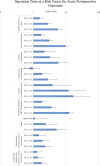Impact of Operation Time on 30-Day Complications After Adult Spinal Deformity Surgery
- PMID: 28989846
- PMCID: PMC5624378
- DOI: 10.1177/2192568217701110
Impact of Operation Time on 30-Day Complications After Adult Spinal Deformity Surgery
Abstract
Study design: Retrospective analysis of prospectively collected data.
Objective: There is a paucity of data on the effect of operative duration on postoperative complications during adult spinal deformity surgery (ASDS). The study attempts to explore and quantify the association between increased operation times and postoperative complications.
Methods: A retrospective cohort analysis was performed on the American College of Surgeons National Surgical Quality Improvement Program (ACS-NSQIP) database from 2010 to 2014. Patients (≥18 years of age) from the NSQIP database undergoing ASDS were separated into cohorts based on quartiles of operation duration. Chi-square and multivariate logistic regression models were used to identify risk factors.
Results: A total of 5338 patients met the inclusion criteria and were divided per quartiles based on operative duration in minutes (154, 235, 346, and 1156 minutes). Multivariate logistic regressions revealed that in comparison to the lowest quartile of operative duration, the highest quartile group was associated significantly with length of stay ≥5 days (odds ratio [OR] = 5.85), any complication (OR = 9.88), wound complication (OR = 5.95), pulmonary complication (OR = 2.85, P = .001), venous thromboembolism (OR = 12.37), intra-/postoperative transfusion (OR = 12.77), sepsis (OR = 5.27), reoperations (OR = 1.48), and unplanned readmissions (OR = 1.29). The odds ratio was higher when comparing a higher quartile group with the reference group across all associations. P < .001 unless otherwise noted.
Conclusion: ASDS operation time is associated with multiple postoperative complications, including, but not limited to, wound and pulmonary complications, venous thromboembolism, postoperative transfusion, length of stay ≥5 days, sepsis, reoperation, and unplanned readmission.
Keywords: ACS-NSQIP; adult spinal deformity surgery; complications; fusion; operation time; outcomes.
Conflict of interest statement
Declaration of Conflicting Interests: The author(s) declared no potential conflicts of interest with respect to the research, authorship, and/or publication of this article.
Figures
Similar articles
-
Nutritional Insufficiency as a Predictor for Adverse Outcomes in Adult Spinal Deformity Surgery.Global Spine J. 2018 Apr;8(2):164-171. doi: 10.1177/2192568217708777. Epub 2017 Jun 30. Global Spine J. 2018. PMID: 29662747 Free PMC article.
-
Thirty-day readmission and reoperation after surgery for spinal tumors: a National Surgical Quality Improvement Program analysis.Neurosurg Focus. 2016 Aug;41(2):E5. doi: 10.3171/2016.5.FOCUS16168. Neurosurg Focus. 2016. PMID: 27476847
-
Incidence, Impact, and Risk Factors for 30-Day Wound Complications Following Elective Adult Spinal Deformity Surgery.Global Spine J. 2017 Aug;7(5):417-424. doi: 10.1177/2192568217699378. Epub 2017 Apr 20. Global Spine J. 2017. PMID: 28811985 Free PMC article.
-
Obese Class III patients at significantly greater risk of multiple complications after lumbar surgery: an analysis of 10,387 patients in the ACS NSQIP database.Spine J. 2014 Sep 1;14(9):2008-18. doi: 10.1016/j.spinee.2013.11.047. Epub 2013 Dec 6. Spine J. 2014. PMID: 24316118
-
Impact of Age on 30-day Complications After Adult Deformity Surgery.Spine (Phila Pa 1976). 2018 Jan 15;43(2):120-126. doi: 10.1097/BRS.0000000000001832. Spine (Phila Pa 1976). 2018. PMID: 27488301
Cited by
-
Machine learning prediction of postoperative unplanned 30-day hospital readmission in older adult.Front Mol Biosci. 2022 Aug 10;9:910688. doi: 10.3389/fmolb.2022.910688. eCollection 2022. Front Mol Biosci. 2022. PMID: 36032677 Free PMC article.
-
Performance of Artificial Intelligence-Based Algorithms to Predict Prolonged Length of Stay after Lumbar Decompression Surgery.J Clin Med. 2022 Jul 13;11(14):4050. doi: 10.3390/jcm11144050. J Clin Med. 2022. PMID: 35887814 Free PMC article.
-
The effect of the cortical bone trajectory screw fixation and traditional pedicle screw fixation on surgical site wound infection in posterior lumbar fusion wound: A meta-analysis.Int Wound J. 2023 Oct;20(8):3241-3248. doi: 10.1111/iwj.14203. Epub 2023 Jun 1. Int Wound J. 2023. Retraction in: Int Wound J. 2025 Feb;22(2):e70203. doi: 10.1111/iwj.70203. PMID: 37264722 Free PMC article. Retracted.
-
Risk factors of perioperative complications for posterior spinal fusion in degenerative scoliosis patients: a retrospective study.BMC Musculoskelet Disord. 2018 Jul 19;19(1):242. doi: 10.1186/s12891-018-2148-x. BMC Musculoskelet Disord. 2018. PMID: 30025521 Free PMC article.
-
Unilateral versus bilateral pedicle screw fixation with anterior lumbar interbody fusion: a comparison of postoperative outcomes.Eur Spine J. 2024 Sep;33(9):3476-3483. doi: 10.1007/s00586-024-08412-5. Epub 2024 Jul 17. Eur Spine J. 2024. PMID: 39014077
References
-
- Schwab F, Dubey A, Gamez L, et al. Adult scoliosis: prevalence, SF-36, and nutritional parameters in an elderly volunteer population. Spine (Phila Pa 1976). 2005;30:1082–1085. - PubMed
-
- Sciubba DM, Scheer JK, Yurter A, et al. Patients with spinal deformity over the age of 75: a retrospective analysis of operative versus non-operative management. Eur Spine J. 2016;25:2433–2441. - PubMed
-
- Baron EM, Albert TJ. Medical complications of surgical treatment of adult spinal deformity and how to avoid them. Spine (Phila Pa 1976). 2006;31(19 suppl):S106–S118. - PubMed
LinkOut - more resources
Full Text Sources
Other Literature Sources
Miscellaneous


